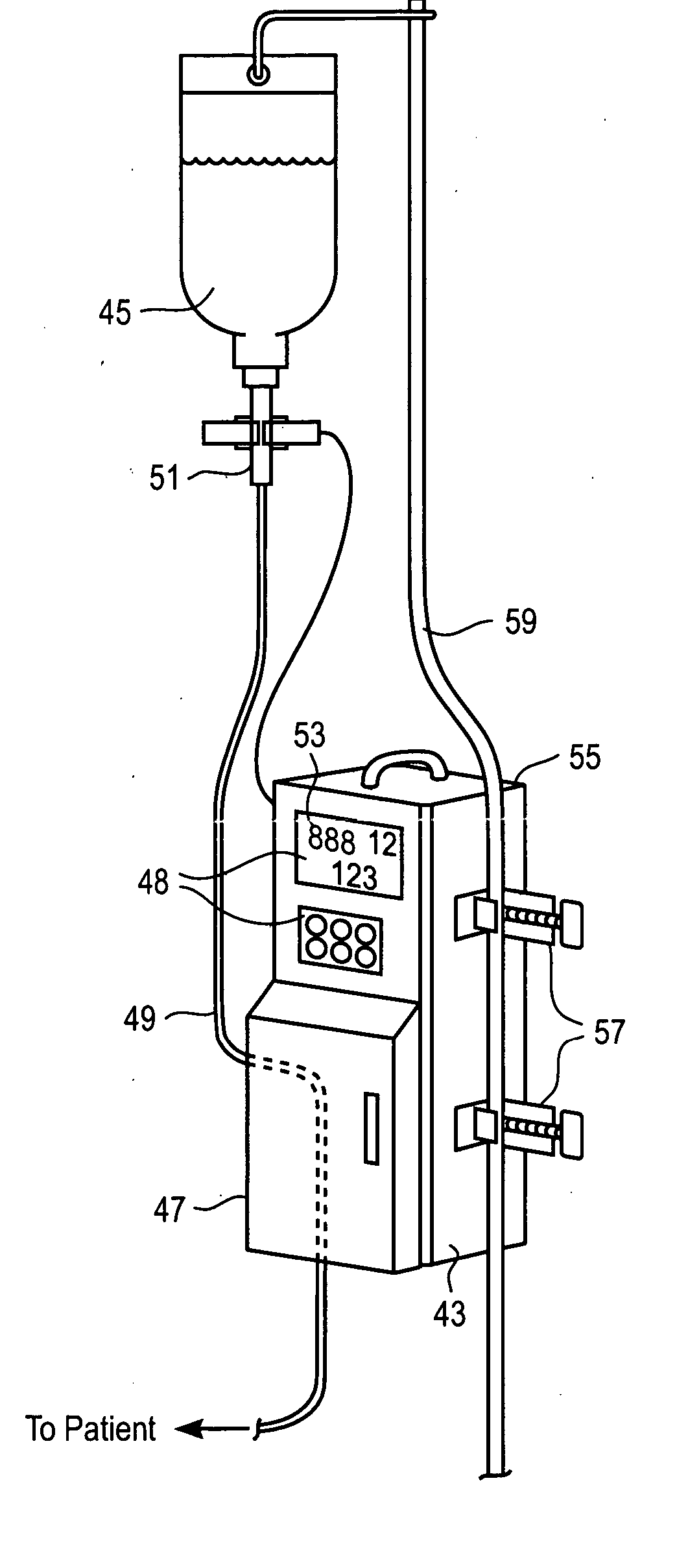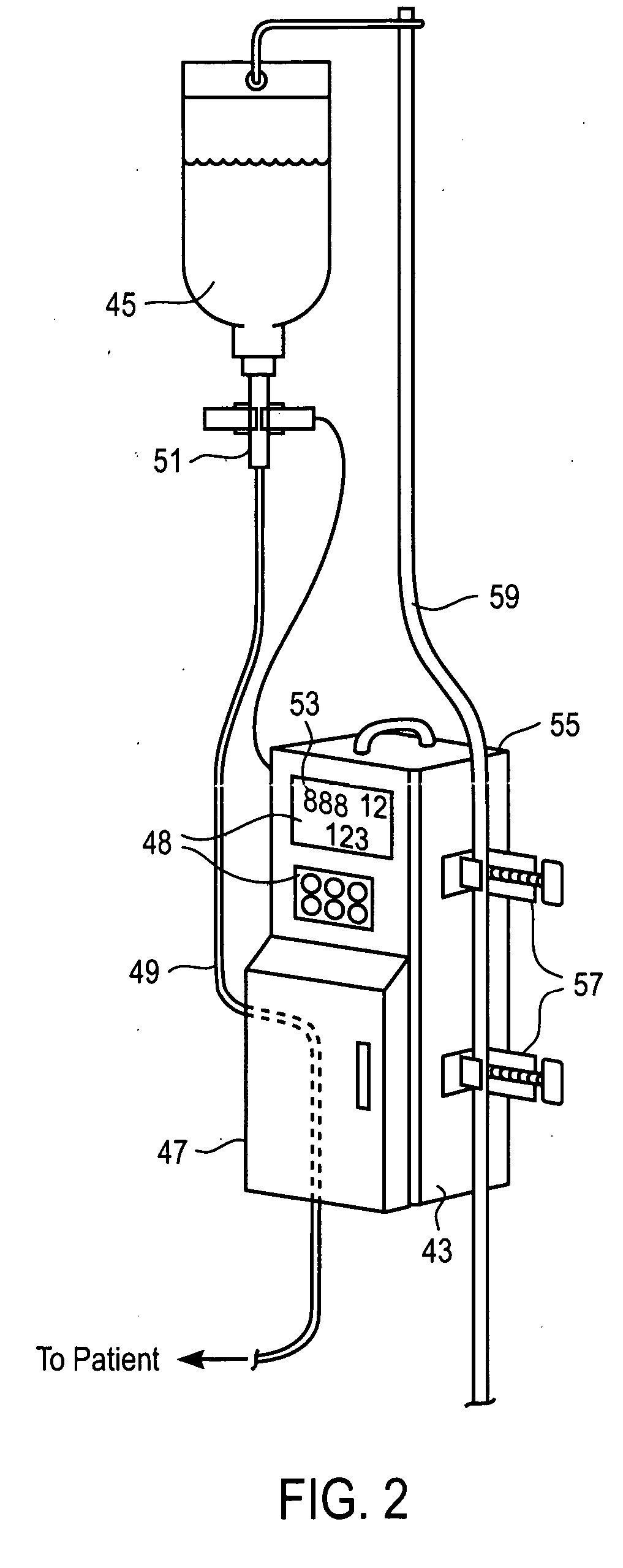[0016] In accordance with the illustrated embodiment of the present invention a safe and effective infusion device for use within the
MRI scan room achieves reduction of magnetic material and accurate pumping control as well as reduction of RF emissions. In one embodiment, the infusion device includes an
ultrasonic motor that eliminates magnetic materials and that does not produce any detrimental magnetic fields and that is not affected by external magnetic fields. The ultrasonic (U / S) motor drives a peristaltic or other suitable fluid pumping mechanism, and is driven by a multiphasic electronic
signal specifically designed to produce very little RF
harmonic noise in the spectral range of about 6 or 8 MHz to about 130 MHz in which MRI receivers are most sensitive. The drive power for the U / S motor is generated via circuitry which produces multiphasic drive signals of at least sine and cosine wareforms at related ultrasonic frequencies. These drive signals are produced as a sinusoidal wave to reduce
high frequency harmonic components which may disturb the MRI's RF-sensitive responsiveness. One scheme for producing these multiphasic signals uses coreless or “
Air Core” transformers constructed with inherent
leakage inductance that interacts with the complex impedance of the U / S motor to convert lower
voltage square wave signals at the primary winding into sinusoidal
high voltage signals at the secondary windings suitable for powering the U / S motor and producing little harmonic RF interference. Alternatively, D.C. voltages of opposite polarities can be alternately switched to supply alternating voltages. The switched signals can be filtered into sinusoidal signals and applied to the inputs of
high voltage linear amplifiers that are set for such
gain as needed to produce
resultant outputs of sufficient
voltage and sinusoidal shape to drive the U / S motor.
[0017]
Control electronics receive commands through an input keypad for setting prescribed fluid flow rates to be delivered, and such inputs are translated into signals to control the U / S motor and pumping mechanism. Various safety devices feed back operational information to the
control electronics, including detection of
motor speed and motion of pump elements, air bubbles in the fluid path, drip rate,
high pressure, low fluid, low / no flow, overtime, and the like. The present infusion device includes battery power for portability, and is housed in one RF-shielded, non-magnetic housing for convenient location anywhere within the
MRI scan room without introducing image degrading RF interference or producing distortions of the
homogeneous magnetic field, and without being affected by the strong magnetic fields or RF energy produced by the MRI
system. Such unrestricted placement of the device is of great importance to the safety and convenience of the attending MRI staff and imaging patient. Further, in the case of a linear
peristaltic pump mechanism, the particular position of pump elements, along with the speed of motion of these elements, must be known to the controller. The degree to which the controller may modulate speed and control exact positions of the pump elements directly affects the resolution and accuracy of the fluid
delivery system. To provide a high degree of speed and position accuracy, an optical
encoder (801, 802) is installed along the main pump shaft. The
encoder disk (802) has many small graticule marks about the circumference, and a single index mark. The optical sensor (801) detects the marks and produces output signals indicative of both the index and individual graticule marks. The index occurs only once each 360 degrees of rotation to facilitate the controller sensing an index to know the position of the pumping elements. The rate at which the graticule marks are sensed indicates the speed of the pump shaft as well as its fine position relative to the index mark. The controller responds to the optical
encoder to modulate the speed of motion of the pump elements at specific positions of the pump shaft in order to reduce inherent non-linearities in fluid delivery of the linear-type
peristaltic pump. In this way, highly accurate and linear fluid flow may be achieved.
[0018] In an additional embodiment, a method is employed to substitute an MRI-compatible pumping device for a prior-connected, non-MRI-compatible pumping device while preserving the patient's connection to a prior-connected primary intravenous (IV)
infusion set. The patient is commonly connected to a primary IV set through a primary, non-MRI-compatible pump. Upon arrival at the MRI suite, a secondary, MRI-compatible pump attached to a secondary IV set connects to the primary IV set to continue actively-pumped IV fluid delivery. The primary pump is disengaged from the patient's installed primary IV set, and a flow preventer (to shut off flow) that is standard on most IV sets is activated to inhibit liquid flow through a segment of the primary IV set. The fluid-receiving or proximal end of the secondary IV set is connected to the upstream end of the primary IV set near the source of the IV fluid. The upstream connection may be conveniently formed by
puncturing a conventional “Y” connector on the primary IV set with a hollow needle on the secondary IV set, or via a luer-type “Y” site connector. Air is flushed from the secondary IV set by flowing fluid from the upstream connection, and the fluid-delivery or distal end of the secondary IV set is then connected in similar manner at a downstream connection in the primary IV set. Pumping of the liquid may then be resumed using the MRI-compatible pump operating on the secondary IV set without having dislodged the intra-vascular needle or actually opening the primary IV circuit. The patient and MRI-compatible pump may then be moved close to the MRI scanner while maintaining the controlled IV therapy. The secondary IV set so employed may simply be disconnected and discarded after the MRI procedure, again without opening the original primary IV circuit, and the original primary IV set may be reinstalled into the original, non-MRI-compatible pump while preserving the patient's connection to the primary IV set. By not opening the fluid circuit of the primary set,
minimal risk to the patient and sterile IV path are achieved as well as reducing
medical waste and cost of replacing the primary IV set after the MRI procedure.
[0019] To facilitate rapid transitions between primary and secondary pumps and infusion sets, one embodiment of the present invention includes an infusion device that receives a liquid conduit for delivering liquid to a patient at volumetric rates that are controllable by the device. Peristaltic pumping of liquid through the conduit installed within the device is enabled only upon proper registration of a flow valve within a receptacle of the device for actuation upon closing of a safety door. Flow of liquid through the conduit is inhibited upon opening the safety door, and various sensors are incorporated into the device along the path of the conduit to detect inflow and outflow liquid pressures, available liquid supply, air bubbles in the conduit, and the like.
 Login to View More
Login to View More  Login to View More
Login to View More 


